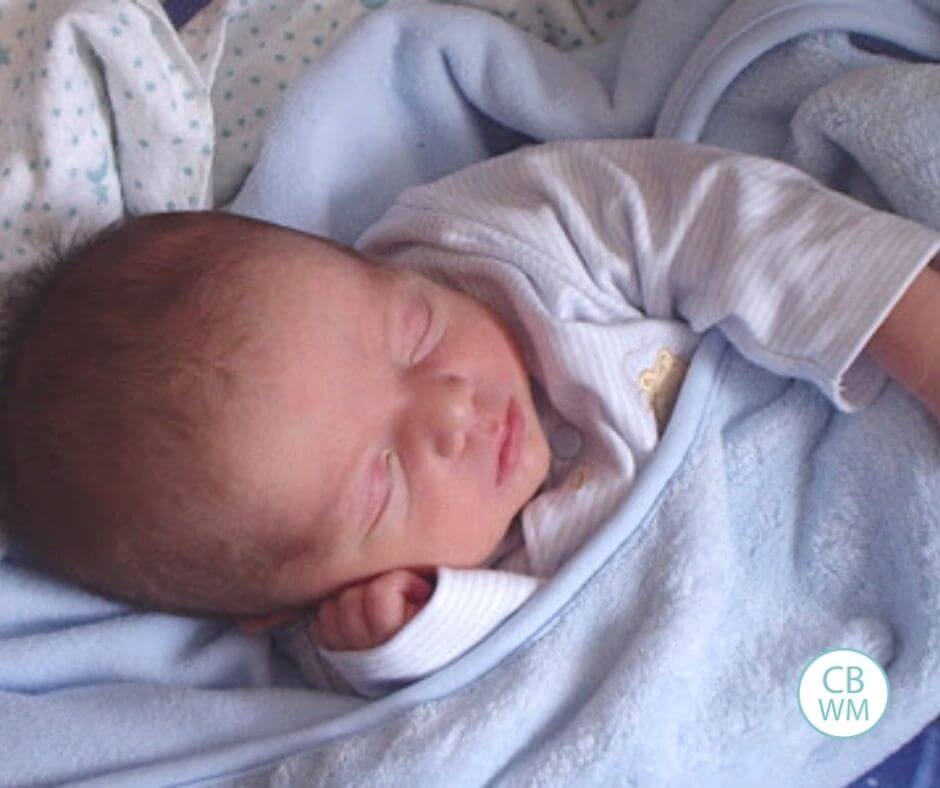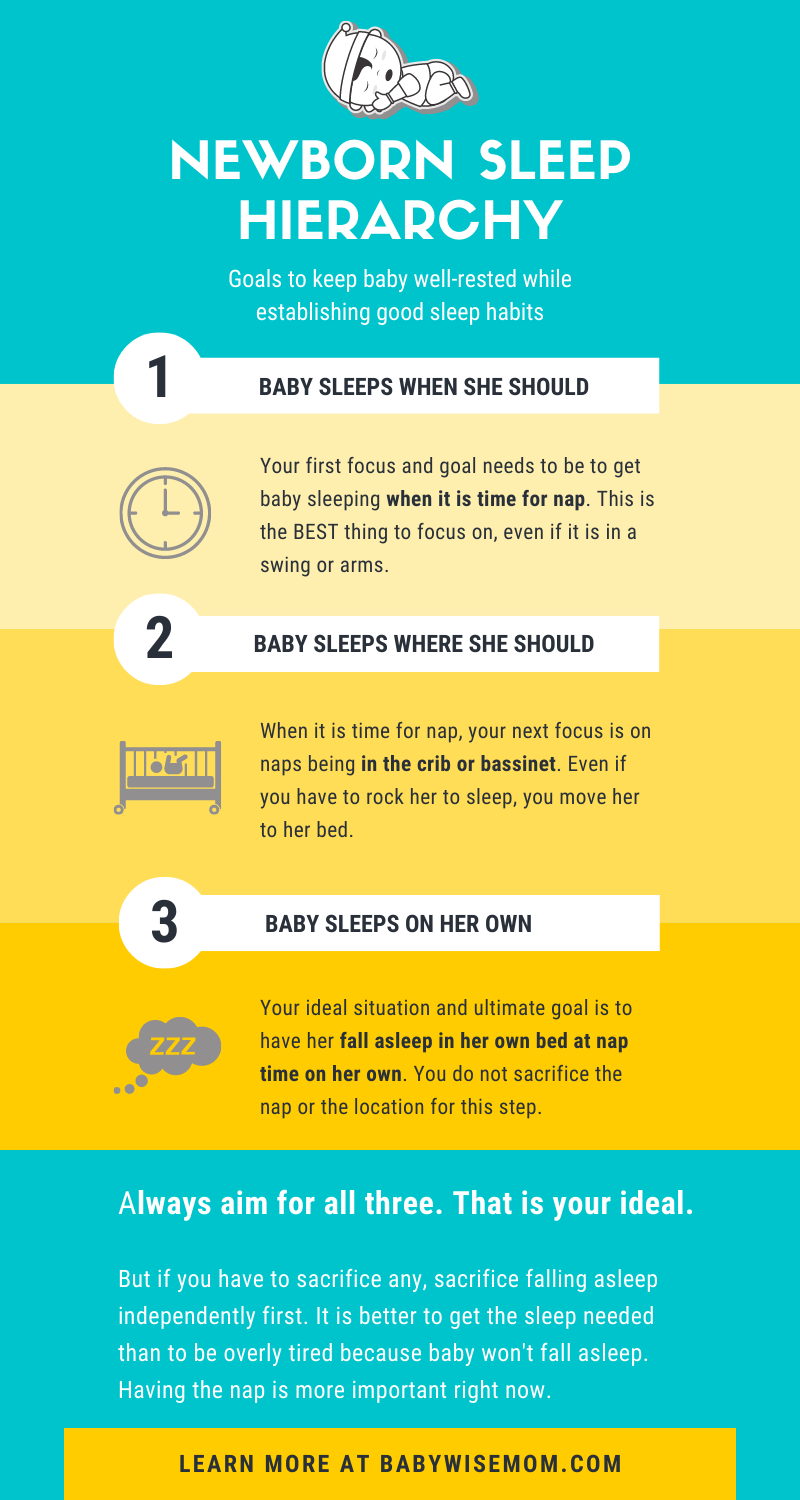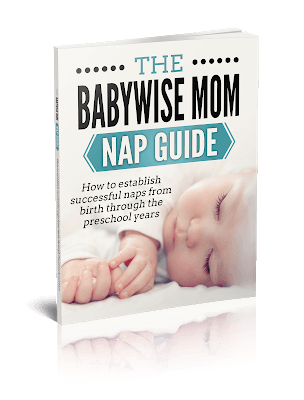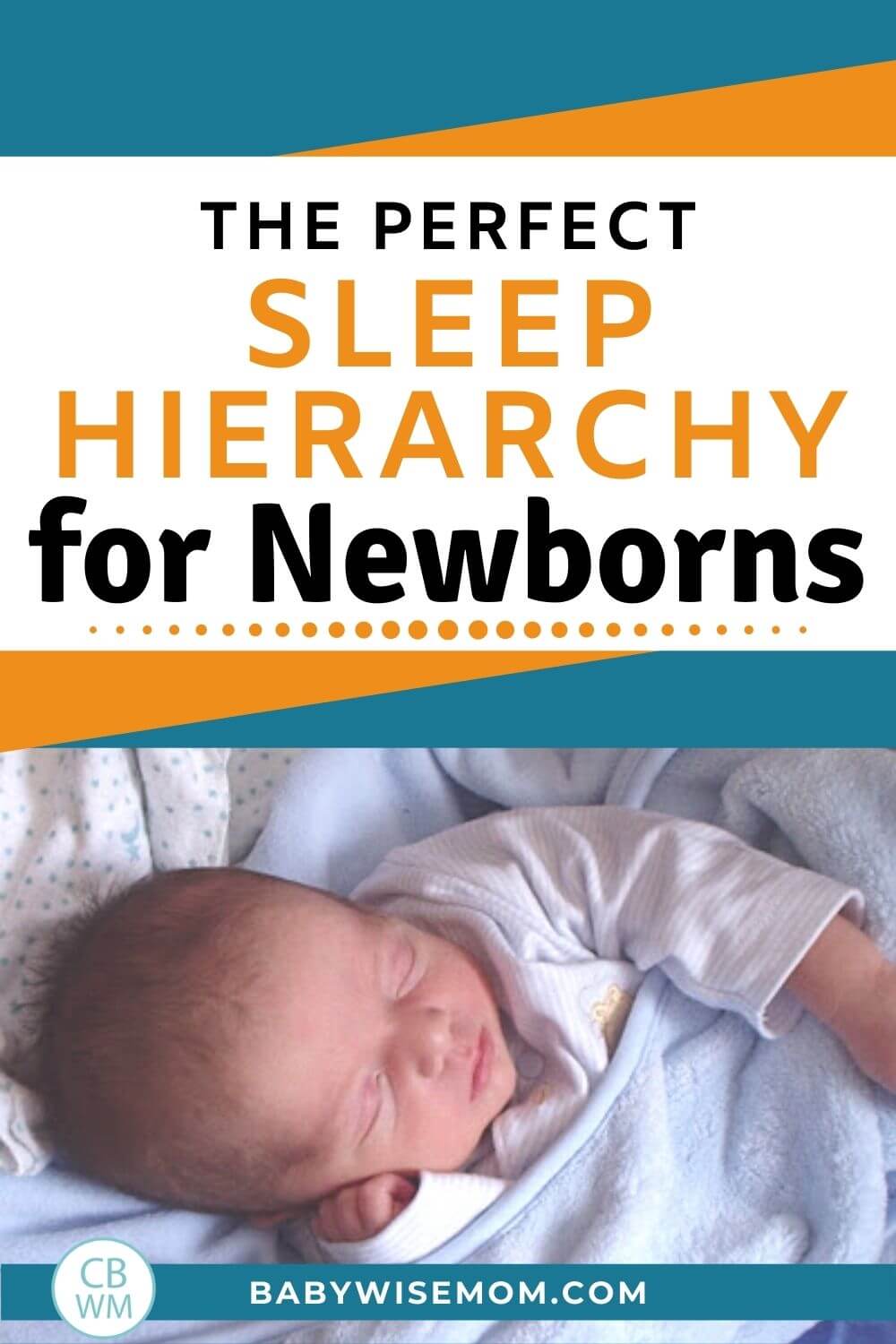How to prioritize and balance your baby sleep schedule and sleep training for your newborn. Get peace of mind sleep training your baby with these newborn sleep tips.

Many times, we get a little stressed out with our newborns in terms of sleep.
We want our newborn to sleep really well and aim to establish solid sleep.
We worry about starting bad habits and we want to teach our little ones healthy sleep patterns.
I have gotten many frazzled phone calls and emails from various people unsure about what to do with the non-sleeping newborn.
What do you do when your newborn won’t sleep or wakes early? How do you make sure your baby gets enough sleep without ruining all future sleep?
Post Contents
- Newborn Sleep Hierarchy
- GOAL #1: Baby Sleeps When She Should
- Establish Solid Sleep
- Thank you!
- GOAL #2: Baby Sleeps When She Should, In Her Own Bed
- GOAL #3: Baby Sleeps When She Should, In Her Own Bed, and Falls Asleep On Her Own
- How To Make It Work
- Tips for Sleep Success
- Understanding Sleep Patterns of a Newborn
- Conclusion
- RELATED POSTS
Newborn Sleep Hierarchy
I have a personal sleep hierarchy for newborns. I have come to this value system on sleep based on my personal experience and a compilation of things I have read in various sleep books.
It is quite simple and comprises of three goals:
- Baby sleeps WHEN she should
- Baby sleeps WHERE she should
- Baby sleeps on her OWN
These goals are numbered because they have a hierarchy. Goal three should not come at the expense of goal one or goal two. You need to fulfill the goals in the correct order.
But also take note that the ideal is that all three goals are met. You don’t want to just aim for goal number one and ignore the other two. If you do that long-term, the day will come that goal one is impossible to reach without some major change.
Let’s discuss each goal in further detail.

GOAL #1: Baby Sleeps When She Should
My number one goal for newborns and sleep is that they sleep when it is time to sleep. I don’t care what it takes for sleep so long as sleep is happening.
If a newborn gets overtired, she isn’t going to sleep well, and that isn’t going to do anyone any good.
She won’t be able to put herself to sleep in that state, which just perpetuates a non-sleep cycle. She also won’t eat well if she is tired, which isn’t healthy. Plus, sleep is important.
So the most important thing is that baby is sleeping when it is time to sleep.
If she is waking early (and isn’t hungry), you want to help her get back to sleep to take a full nap.
>>>Read: How To Calm Your Overstimulated Baby
Please note, you always want to follow safe sleep practices and recommendations. These are in place to reduce the risk of SIDS (Sudden Infant Death Syndrome).
You want to avoid loose bedding and items in the crib, such as pillows, toys, quilts, and crib bumpers. It is also recommended by the AAP (American Academy of Pediatrics) that baby go to sleep on her back and not her stomach. You want to have a safe sleep environment to avoid suffocation.
GOAL #2: Baby Sleeps When She Should, In Her Own Bed
Of course, there are risks and problems with baby sleeping at all costs.
You can get her to sleep when she should, but create problems down the road that lead her to not sleep when she should because she is too dependent on sleep props.
>>>Read: When Sleep Props Are Okay (And When to Avoid Them)
One common sleep prop is the swing or sleep through baby wearing.
A major problem in my mind with baby sleeping in a swing or in a sling is that sleep while in motion is not as restorative as stationary sleep.
So if you do use motion to get baby to sleep, it is best to have the nap take place in a stationary place, like her own bed (the crib or bassinet).
In the book Healthy Sleep Habits, Happy Child, Weissbluth suggests if you have baby fall asleep in a swing that you turn the swing off once she is asleep.
Stationary sleep is far superior to sleep while in motion. Sleep while in motion does not allow the body to get into as deep of sleep.
So, even better than baby sleeping when she should is baby sleeping in her bed when she should.
>>>Read: 9 Effective Tips to Get Baby to Sleep in the Crib
GOAL #3: Baby Sleeps When She Should, In Her Own Bed, and Falls Asleep On Her Own
The ultimate goal is to have your child sleep when she should, in her bed, and fall asleep on her own.
This is what is going to get her the most benefits from sleeping.
A risk of having baby sleep at all costs is starting bad habits–like being unable to fall asleep unless she is in a swing.
This third goal is the best case scenario–this is what you are ultimately striving for.
But goal three shouldn’t completely replace goal one. For a newborn, sleeping is most important.
You don’t want her skipping all daytime naps because you are determined she will fall asleep on her own no matter what.
So if you put her down in her bed awake and she has a hard time falling asleep, my thinking is it is best to help her fall asleep so you can try again next time.
Odds are she is having a hard time falling asleep because she is over tired or over stimulated.
If you help her fall asleep, you can try again next nap to get the timing right. If not, she will be overly tired perpetually. You cannot have sleep training success if your baby is overly tired.
How To Make It Work
I recommend that you start with the end in mind. Aim for goal number 3. Go about your day as though goal number three will happen. If it doesn’t work out for a nap, scale back to goal two or even goal one.
For the next nap, aim for goal three again.
I definitely understand the desire to avoid sleep problems down the road. Start as you mean to go on!
McKenna went to sleep on her own for every nap and bedtime starting at three days old. She did this without crying, but I didn’t know for sure she would do that the first time I put her down.
Brinley also went to sleep on her own from the very beginning.
Yes, I highly value good habits from the start.
>>>See what sleep training method I used with McKenna and Brinley here.
Part of that is because I allowed and started bad habits with Brayden from the start.
When we finally went to cry it out (CIO) with him, he had a hard time because he wasn’t just learning how to sleep on his own, he was unlearning all of these props he had been supplied with.
Of all my kids, he had the hardest run with sleep training–the most intense crying. It took him the longest to get it and be able to sleep independently.
I do believe if you can get them in the right habits from the beginning, it will be easier on them in the long run.
However, you have time to work on things in the future. Do not sacrifice sleep today unnecessarily. Do not stress when sleep isn’t the perfect Goal 3. This is a learning process and can take time.
Tips for Sleep Success
For some babies, the smallest things can make or break a nap. Make sure diapers are fresh and clean before the nap starts. Diaper changes should be part of your bedtime routine.
Make sure you have a bedtime routine you follow before each nap and bedtime.
Pay attention to sleep cues (eye-rubbing, yawning, fussiness, etc.). Pay attention and figure out the right sleep cues for your baby.
Do not respond every time you hear some fussing. You always want to respond when your baby seems to be in great need, but fussing is okay.
Make sure the room temperature is right for your baby (read Finding the Ideal Temperature for Your Child’s Sleep).
If baby fusses some to fall asleep, give it 5-10 minutes and see if baby will go to sleep. If baby wakes up in the middle of a nap, wait 10 minutes before going in and see if your baby will resettle and go back to sleep.
Understanding Sleep Patterns of a Newborn
A newborn will fall asleep and go straight to REM sleep. After 45 minutes, that sleep will change to non-REM sleep. Newborns have active sleep (REM-rapid eye movement) and quiet sleep.
During active sleep, your newborn will move and make noises–newborns are very noisy! Active sleep is a very light sleep. During this time, your baby will be easy to wake up.
Quiet sleep is a deep sleep when it is harder to wake baby up.
>>>Read: Newborn Sleep Patterns
Baby is also easy to wake up during sleep transition–the time between active and quiet sleep.
Conclusion
This is my newborn sleep hierarchy; a sleep hierarchy and my practices would be different for infants 3 months and older.
But for the newborn, it sleep is the most important goal right now. It is a fine balancing act between establishing good sleep habits and allowing for sleep.
It is one you will likely stumble and fumble with along the way–especially your first time around. But you can get it.
Try your best to not stress about it. If your baby needs help falling asleep, there is always the next nap. So long as baby doesn’t get too tired, you will be able to keep working at it.
RELATED POSTS
- Sleep Hierarchy: 3-6 Months
- Start as You Mean to Go On As a Parent
- Consistent Schedule: Start Your Day Right
- Establishing Consistency–Make Sacrifices
- Cry It Out Bootcamp
- How To Do Cry It Out Responsibly
- Optimal Waketime Lengths
- Sleep Training According To Babywise
- Sleep Training: The Four S’s

Get your copy of The Babywise Mom Nap Guide eBook today to get your baby sleeping better!

This post originally appeared on this blog June 2010



